
The Ombudsman for Injured Workers
Contacts, Inquirers and Issues
Introduction
The Ombudsman for Injured Workers is an independent advocate helping those in the workers compensation system that have experienced problems in the administration of their workers compensation claims. The Ombudsman answers questions about the workers compensation system, helps to resolve conflict between opposing parties, and gives educational seminars to insurance companies, labor unions, and others involved in injured workers issues. The Ombudsman reports directly to the Director of the Department of Consumer and Business Services. The office of the Ombudsman was established by the Legislature in 1987 and now has five staff in addition to the Ombudsman. This report focuses first on number of contacts the office has had over the years, and then the source of contacts with the office. Finally the report focuses on the issues that are bringing workers to the office, and how these issues have changed over the past two years.
I. Contacts
Records of contacts have been kept since 1988. In 1997 the procedure for counting contacts changed so the earlier counts cannot be compared to the recent counts. The procedure now is to count all telephone calls (incoming and outgoing), walk-ins, and mail contacts. As Figure 1 below shows, there were over five times as many contacts in 1996 as in 1988.
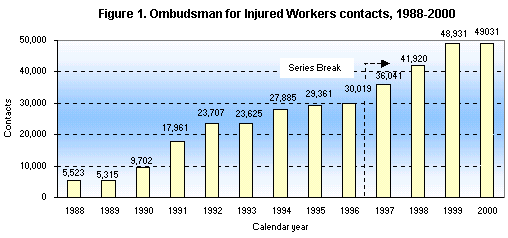
From 1997 to 2000 contacts have increased over 10 percent a year. The contacts primarily come from injured workers, but are also initiated by attorneys, insurance companies, employers and a variety of other sources. Table 1 shows inquiries from different groups as a percent of total inquiries from 1999 through 2000. In Table 1, inquiries are not the same as contacts. Most inquiries result in multiple contacts.
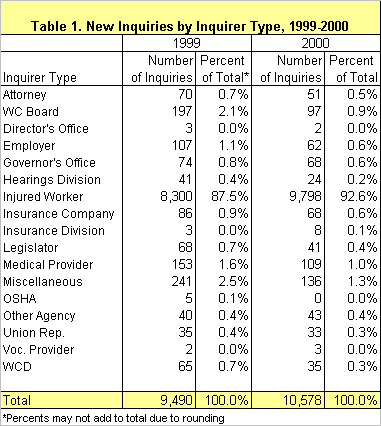
Table 1 shows that inquiries come predominantly from injured workers. In 1999 there were 8,300 new inquiries from injured workers, out of a total of 9,490, or almost 88 percent. In 2000 inquiries by injured workers increased 18.0 percent to 9,798. Next in importance are inquiries from miscellaneous sources and medical providers. In 1999 there were 153 from medical providers, while in 2000 these actually decreased to 109.
Since 1998 the Ombudsman has gathered data on inquiries from non-English speaking individuals. Figure 2 shows that bilingual contacts have increased dramatically from 826 to 1,938 from 1998 to 2000, or by 135 percent.
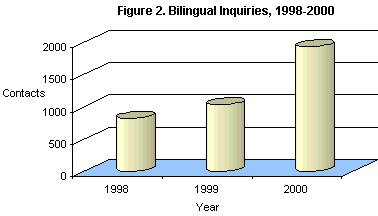
II. Issues
The myriad of issues that motivate people to contact the Ombudsman can be grouped into 10 broad categories. For example, problems with medical bills and medical treatment rights are grouped under "Medical Issues." Legal issues such as inability to find attorney representation or claimant problems with representation are grouped under Attorney issues. Issues concerning out of state employers and all issues that can't be grouped under one of the other nine areas are grouped under "other issues." Table 2 shows the percent distribution of new issues from 1999 through 2000 when all issues are placed into 10 groups.
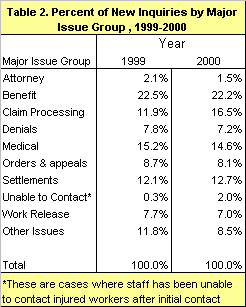 Table
2 shows that benefit issues prompted the most inquiries in both 1999
and 2000. Medical, settlements and claim processing also motivated many
people to contact the Ombudsman.
Table
2 shows that benefit issues prompted the most inquiries in both 1999
and 2000. Medical, settlements and claim processing also motivated many
people to contact the Ombudsman.
Table 3 shows a much more comprehensive list of
specific issues, and gives a sense of the diversity of the topics that
bring people to the Ombudsman's office. In Table 3 the number and
percent distribution of issues behind the inquiries from 1999 through
2000 is given, without issues being placed into overall categories. We
can see below that Time Loss is the most frequent issue in both years.
In 1999 there were 1,334 total time loss issues and in the following year
1,533. Also important in both years are issues around medical treatment
rights, claims denial and claims disposition agreements. Other issues
includes those that cannot be fitted into any of the other types, such
as problems workers might have with the state regulation of the workers'
compensation system. Overall the number of issues increased by 4.3 percent
from 1999 to 2000.
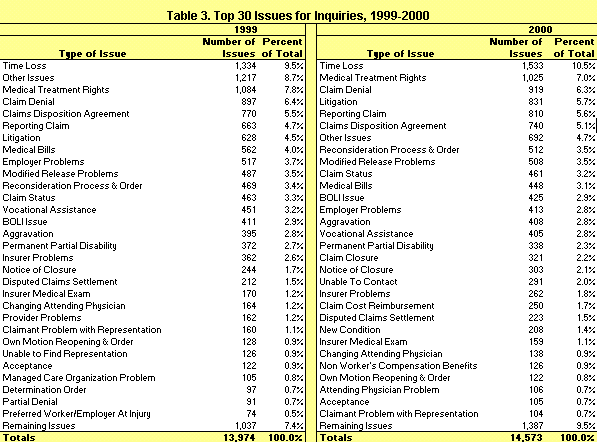
DCBS Public Home Page | DCBS
Site Search | IMD
Search |IMD Home
Page| Ombudsman Home Page
If you have questions, about the information contained in this document please contact by e-mail or phone: Clifton.Hindmarsh, Research Analyst, Research & Analysis Section, Information Management Division (503) 947-7053
This web page was last revised: 04/10/01.